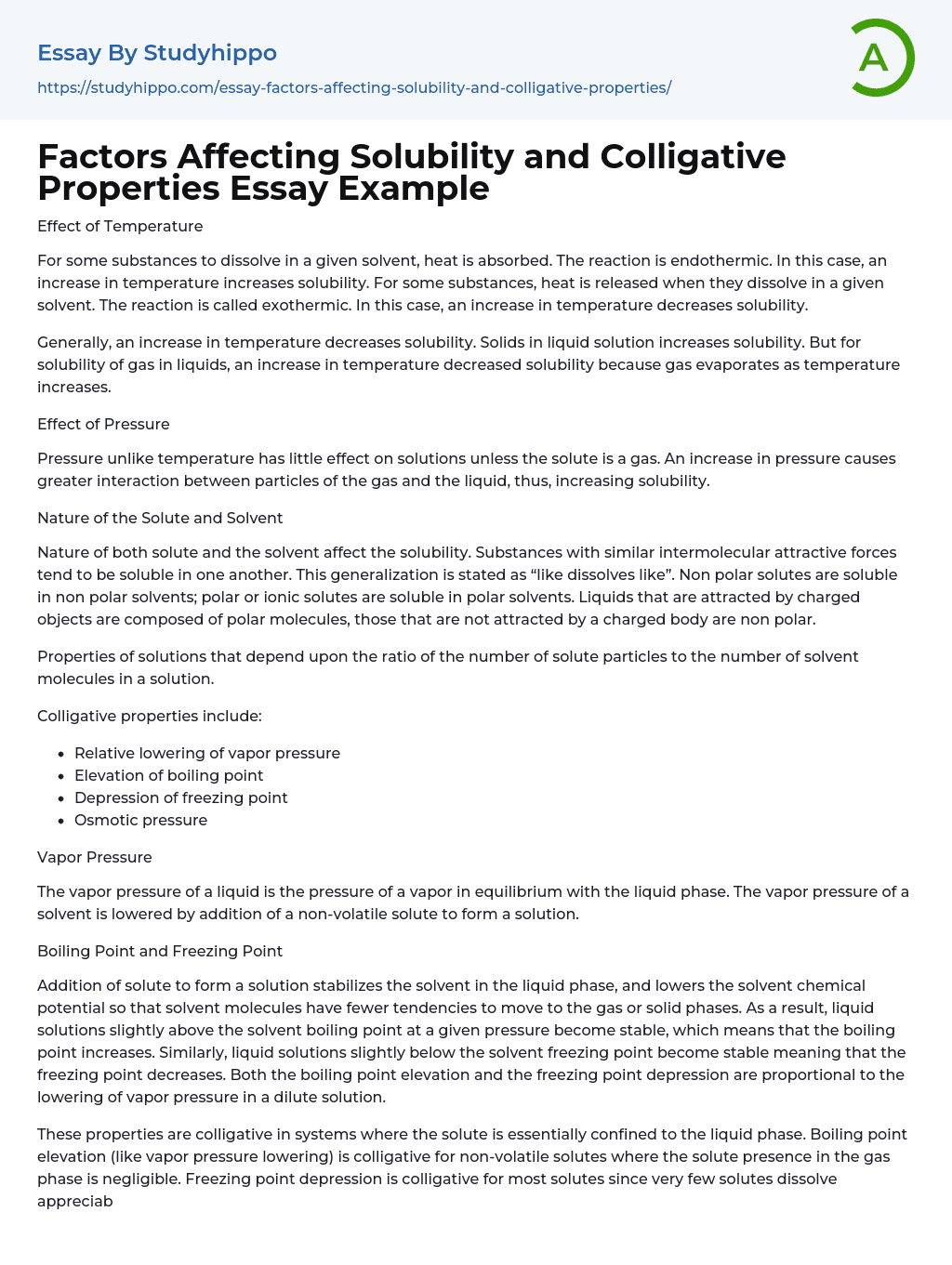

Factors Affecting Solubility and Colligative Properties Essay Example
Effect of Temperature
For some substances to dissolve in a given solvent, heat is absorbed. The reaction is endothermic. In this case, an increase in temperature increases solubility. For some substances, heat is released when they dissolve in a given solvent. The reaction is called exothermic. In this case, an increase in temperature decreases solubility.
Generally, an increase in temperature decreases solubility. Solids in liquid solution increases solubility. But for solubility of gas in liquids, an increase in temperature decreased solubility because gas evaporates as temperature increases.
Effect of Pressure
Pressure unlike temperature has little effect on solutions unless the solute is a gas. An increase in pressure causes greater interaction between particles of the gas and the liquid, thus, increasing solubility.
Nature of the Solute and Solvent
Nature of
...both solute and the solvent affect the solubility. Substances with similar intermolecular attractive forces tend to be soluble in one another. This generalization is stated as “like dissolves like”. Non polar solutes are soluble in non polar solvents; polar or ionic solutes are soluble in polar solvents. Liquids that are attracted by charged objects are composed of polar molecules, those that are not attracted by a charged body are non polar.
Properties of solutions that depend upon the ratio of the number of solute particles to the number of solvent molecules in a solution.
Colligative properties include:
- Relative lowering of vapor pressure
- Elevation of boiling point
- Depression of freezing point
- Osmotic pressure
Vapor Pressure
The vapor pressure of a liquid is the pressure of
vapor in equilibrium with the liquid phase. The vapor pressure of a solvent is lowered by addition of a non-volatile solute to form a solution.
Boiling Point and Freezing Point
Addition of solute to form a solution stabilizes the solvent in the liquid phase, and lowers the solvent chemical potential so that solvent molecules have fewer tendencies to move to the gas or solid phases. As a result, liquid solutions slightly above the solvent boiling point at a given pressure become stable, which means that the boiling point increases. Similarly, liquid solutions slightly below the solvent freezing point become stable meaning that the freezing point decreases. Both the boiling point elevation and the freezing point depression are proportional to the lowering of vapor pressure in a dilute solution.
These properties are colligative in systems where the solute is essentially confined to the liquid phase. Boiling point elevation (like vapor pressure lowering) is colligative for non-volatile solutes where the solute presence in the gas phase is negligible. Freezing point depression is colligative for most solutes since very few solutes dissolve appreciably in solid solvents.
Boiling Point Elevation (Ebullioscopy)
Boiling point elevation occurs when the boiling point of a solution becomes higher than the boiling point of a pure solvent. The temperature at which the solvent boils is increased by adding any non-volatile solute. A common example of boiling point elevation can be observed by adding salt to water. The boiling point of the water is increased.
Boiling point elevation, like freezing point depression, is a colligative property of matter. This means it depends on the number of particles present in
a solution and not on the type of particles or their mass.
Freezing Point Depression (Cryoscopy)
Freezing point depression occurs when the freezing point of a liquid is lowered by adding another compound to it. The solution has a lower freezing point than that of the pure solvent.
For example, the freezing point of seawater is lower than that of pure water. The freezing point of water to which antifreeze has been added is lower than that of pure water.
Freezing point depression is a colligative property of matter. Colligative properties depend on the number of particles present, not on the type of particles or their mass.
Osmotic Pressure
The osmotic pressure of a solution is the difference in pressure between the solution and the pure liquid solvent when the two are in equilibrium across a semi-permeable membrane, which allows the passage of solvent molecules but not of solute particles. If the two phases are at the same initial pressure, there is a net transfer of solvent across the membrane into the solution known as osmosis. The process stops and equilibrium is attained when the pressure difference equals the osmotic pressure.
- The osmotic pressure of a dilute solution at constant temperature is directly proportional to its concentration.
- The osmotic pressure of a solution is directly proportional to its absolute temperature.
- Organic Chemistry essays
- Acid essays
- Calcium essays
- Chemical Bond essays
- Chemical Reaction essays
- Chromatography essays
- Ethanol essays
- Hydrogen essays
- Periodic Table essays
- Titration essays
- Chemical reactions essays
- Osmosis essays
- Carbohydrate essays
- Carbon essays
- Ph essays
- Diffusion essays
- Copper essays
- Salt essays
- Concentration essays
- Sodium essays
- Distillation essays
- Amylase essays
- Magnesium essays
- Acid Rain essays
- Oxygen essays
- Atmosphere essays
- Coral Reef essays
- Desert essays
- Earth essays
- Ocean essays
- Lake essays
- Sea essays
- Biodiversity essays
- Natural Environment essays
- Forest essays
- Soil essays
- Water essays
- Rainbow essays
- Ecosystem essays
- Volcano essays
- Wind essays
- Forestry essays
- Bottled Water essays
- Melting essays
- Agriculture essays
- Albert einstein essays
- Animals essays
- Archaeology essays
- Bear essays
- Biology essays



